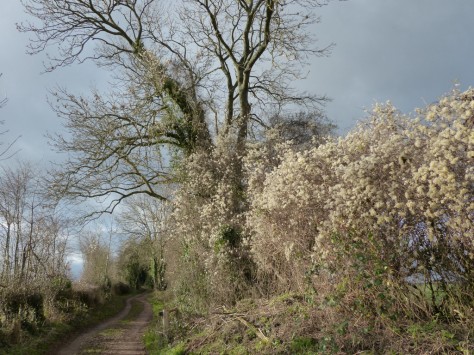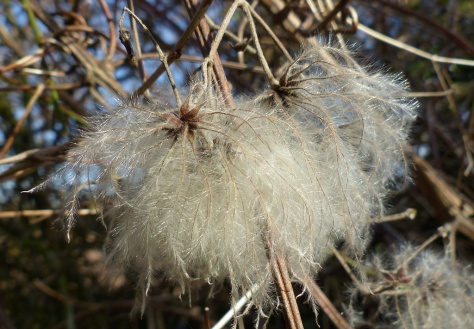The dog is getting a bit cheeky.
Christmas is a very busy time of year for me. It is the only time of year when having long white hair and a beard can actually lead to gainful employment. I have been so busy polishing my Reindeer’s hooves (and keeping them off the Fly Agaric) that I haven’t had time to write a proper post.
What would you like for Christmas, little fellow?
A puppy? Oh I think that we could manage that….
 What do you mean, “You want a cute one?” Get out’a here!
What do you mean, “You want a cute one?” Get out’a here!
 Oh shut up! You wouldn’t give me away.
Oh shut up! You wouldn’t give me away.
🙂
So anyway this is the best that I could manage today. It is a rehash of something that I posted elsewhere.
Clematis vitalba, The Wild Clematis
Clematis vitalba also known as Old Man’s Beard or Traveller’s Joy.
 I see Old Man’s Beard in the winter.
I see Old Man’s Beard in the winter.
 Traveller’s Joy in the summer.
Traveller’s Joy in the summer.
Other less common names relate to it’s use as a tobacco substitute, for example, Smoke Wood or Boy’s Bacca. The woody stems contain large vessels which allow air to pass through them and it was once the habit to break off pieces of the stem and smoke it like a cigar.
Clematis vitalba is a member of the Buttercup family and the only member of that family to have woody stems.
 Native to the UK and most common in the south , it is a climbing vine or Liana. It’s roots are in the soil and it climbs toward the light by curling the stems of it’s leaflets around trees and shrubs.
Native to the UK and most common in the south , it is a climbing vine or Liana. It’s roots are in the soil and it climbs toward the light by curling the stems of it’s leaflets around trees and shrubs.
Old Man’s Beard is a familiar sight in the winter scrambling through and topping the hedgerows.
 The leaves are made up of three to five leaflets on a central stem and these leaflets are spaced apart with two opposite pairs and one at the end. It is usually five, three leaflets are only common on young plants.
The leaves are made up of three to five leaflets on a central stem and these leaflets are spaced apart with two opposite pairs and one at the end. It is usually five, three leaflets are only common on young plants.
The ability of these leaflets to curl around anything they find in their way is central to the success of the plant. An unsupported vine can only grow toward the light for about one metre before it drops and grows along the ground.
 In the UK the flowers open in the second half of July.
In the UK the flowers open in the second half of July.
 The flowers don’t have petals. They have four sepals which open to reveal numerous stamens and styles. The flower is hermaphrodite.
The flowers don’t have petals. They have four sepals which open to reveal numerous stamens and styles. The flower is hermaphrodite.




 The late summer flowers often coincide with the ripening fruits of the plant that they are climbing, as in these next pictures of the vine growing through Elder.
The late summer flowers often coincide with the ripening fruits of the plant that they are climbing, as in these next pictures of the vine growing through Elder.




 As the Elder berries are ripening so is the Clematis. The sepals and stamens are discarded and the green seeds form at the base of the styles.
As the Elder berries are ripening so is the Clematis. The sepals and stamens are discarded and the green seeds form at the base of the styles.
 The styles start to elongate and become feathery. They will remain attached to the seed and serve to distribute the seed on the wind.
The styles start to elongate and become feathery. They will remain attached to the seed and serve to distribute the seed on the wind.
 The host plant in these next pictures is Hawthorn. I just mention this in case anyone thinks that Wild Clematis has berries of any kind. Of course it doesn’t, the seeds that we are looking at are its fruit.
The host plant in these next pictures is Hawthorn. I just mention this in case anyone thinks that Wild Clematis has berries of any kind. Of course it doesn’t, the seeds that we are looking at are its fruit.
 The seeds change from green to brown as they ripen.
The seeds change from green to brown as they ripen.



 In September the summer flowers start to turn into the Old Man’s Beard that will hang on the vines all winter, often lasting well into April or even May.
In September the summer flowers start to turn into the Old Man’s Beard that will hang on the vines all winter, often lasting well into April or even May.
The seeds provide a valuable source of food for birds throughout the winter.
This vine is very important to our wildlife. Apart from the seeds provided for the birds the flowers are a rich source of nectar for visiting insects and the leaves provide the larval food for several native moths. In fact there are several species that are completely dependent on Clematis vitalba as their sole larval food plant, these include the Small Emerald Moth, The Small Waved Umber and Haworth’s Pug.
 Native to the UK and much of Southern and Western Europe these vines play a vital role in our ecology. They fit well into our crowded hedgerows and they do not outgrow themselves. Elsewhere in the world they are much less welcome.
Native to the UK and much of Southern and Western Europe these vines play a vital role in our ecology. They fit well into our crowded hedgerows and they do not outgrow themselves. Elsewhere in the world they are much less welcome.
It is particularly unwelcome in New Zealand where it is considered an “unwanted organism” and a “national pest.” A milder climate and a lack of natural control agents means that Wild Clematis grows much more vigorously over there. The flowers only open in full sun and the habit of the vine is to grow to the top of the tree before flowering. The leaves smother whatever it is growing through and deprive the host plants of sunlight.
Even here it can cause problems. The vines can grow as thick as your wrist and more.
 They can hang from a tree in great numbers and mass. Their sheer weight and wind resistance can be enough to break branches or even topple a tree.
They can hang from a tree in great numbers and mass. Their sheer weight and wind resistance can be enough to break branches or even topple a tree.
 However they do also provide the only real opportunity in the UK to play Tarzan and swing through the jungle and for that they should be valued. (you can swing on them but just like Tarzan, you may hurt your bum if they break)
However they do also provide the only real opportunity in the UK to play Tarzan and swing through the jungle and for that they should be valued. (you can swing on them but just like Tarzan, you may hurt your bum if they break)
 I have heard it said that the stems make a good natural tinder for starting a fire but in my experience I think that it absorbs moisture very easily and in winter it is always wet and useless. It needs to be dry, perhaps in summer. (The feathery seeds dry quickly and are like cotton wool for taking a spark but they don’t last long)
I have heard it said that the stems make a good natural tinder for starting a fire but in my experience I think that it absorbs moisture very easily and in winter it is always wet and useless. It needs to be dry, perhaps in summer. (The feathery seeds dry quickly and are like cotton wool for taking a spark but they don’t last long)
Taxonomy:
Kingdom: Plantae
Order: Ranunculales
Family: Ranunculaceae
Genus: Clematis
Species: Clematis vitalba
That last picture was taken yesterday and is exactly how things are here in the UK in December 🙂
































